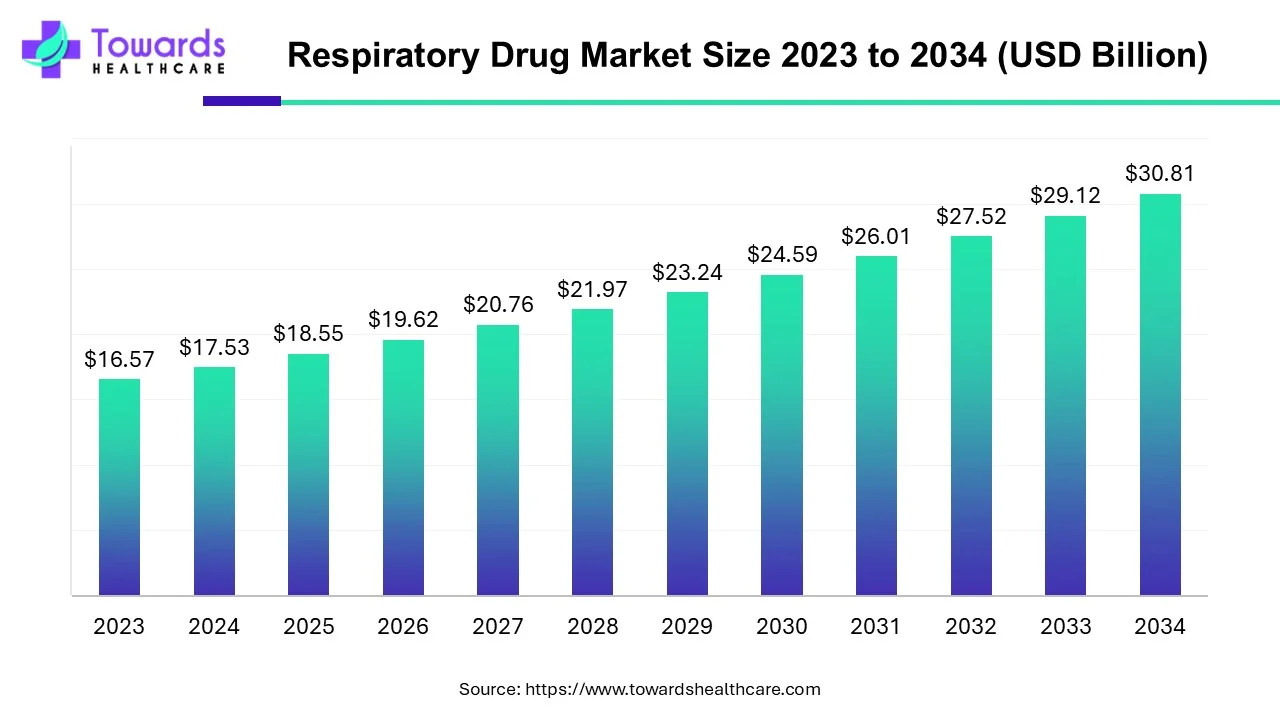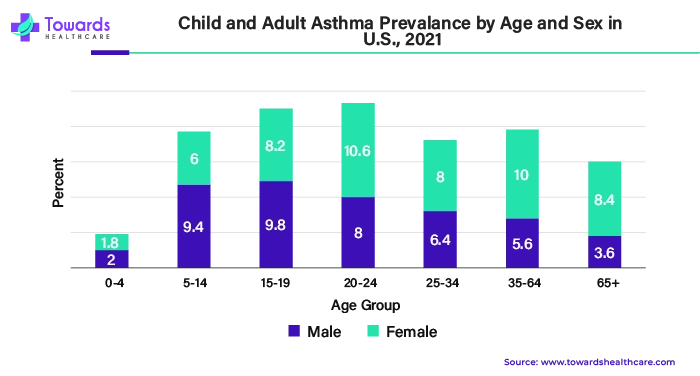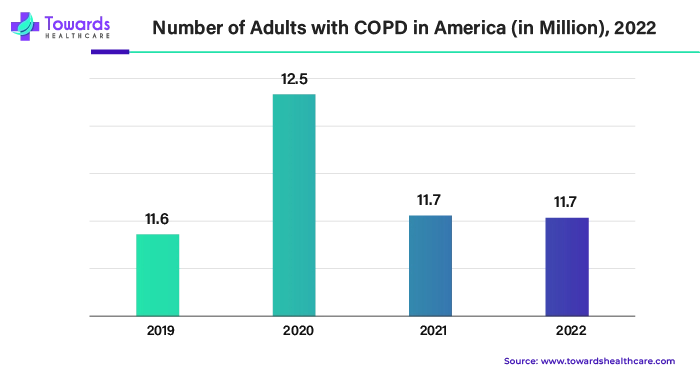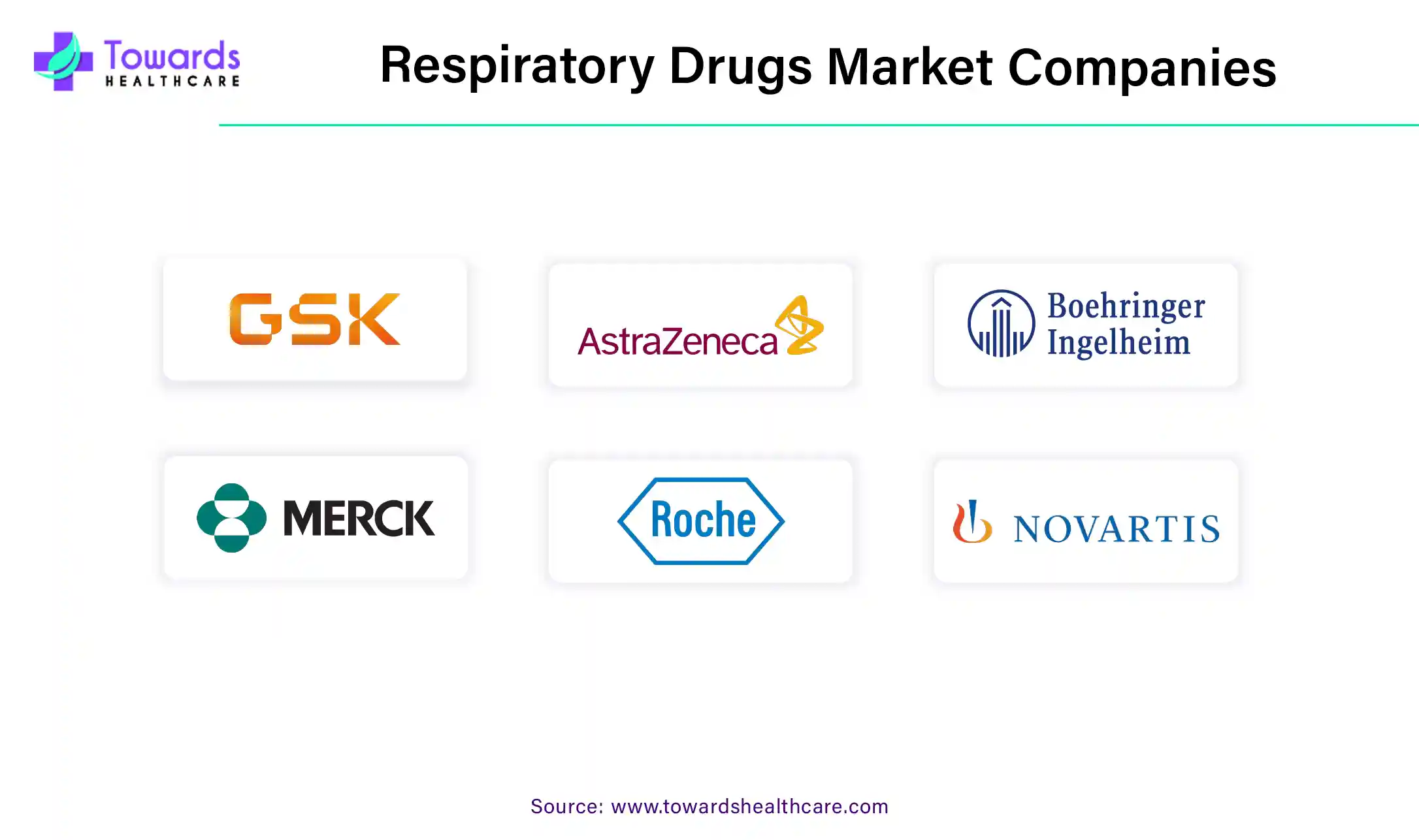January 2026

The respiratory drugs market size is forecast to grow at a CAGR of 5.8%, from USD 18.55 billion in 2025 to USD 30.81 billion by 2034, over the forecast period from 2025 to 2034.

In 2021, the CDC reported 142,342 deaths from lower chronic respiratory disease in the United States, highlighting the urgent need for innovative treatment approaches. This significant toll underscores the demand for advancements in managing these conditions effectively.
Respiratory disorders cover a broad range of issues affecting the system responsible for breathing, including the lungs, airways, and respiratory muscles. When these parts of the body encounter problems, it can make breathing difficult and lead to various symptoms like coughing, wheezing, shortness of breath, and chest tightness. There are several respiratory disorders, each with its characteristics and causes. Obstructive disorders, such as asthma and chronic obstructive pulmonary disease (COPD), involve blockages in the airways, hindering airflow in and out of the lungs. Restrictive disorders, like pulmonary fibrosis, limit the lungs' ability to expand fully, making breathing hard.

As more people are found to have respiratory disorders, there's a growing demand for treatments that can ease symptoms and enhance life quality. Effective treatments can reduce symptoms, prevent complications, and support active lifestyles despite the condition. According to the CDC, diabetes mellitus was the most common medical risk factor for TB illness in 2021 (23.9%), while 4.2% of TB patients were also diagnosed with HIV. Additionally, advancements in medical research are leading to new treatments like bronchodilators and corticosteroids for symptom relief, targeted therapies for lung cancer and pulmonary rehabilitation programs to boost lung function and overall health.
Infections caused by viruses, bacteria, fungi, or other pathogens can also affect the respiratory system, leading to illnesses like the common cold, influenza, pneumonia, tuberculosis, and respiratory syncytial virus (RSV) infection. Inflammatory disorders, including bronchitis and allergic rhinitis, involve airways or lung tissue inflammation, resulting in breathing difficulties and discomfort. Neoplastic disorders, like lung cancer, involve abnormal cell growth in the respiratory system, which can lead to serious health complications.
Respiratory disorders can stem from various factors, including genetic predisposition, environmental factors like pollution and exposure to tobacco smoke, infections, lifestyle choices such as smoking and poor nutrition, and occupational exposures to dust, chemicals, or fumes. It's crucial to address these underlying causes to manage respiratory conditions effectively.
Appropriate treatment is essential for managing respiratory disorders and improving patients' quality of life. Treatment aims to alleviate symptoms, slow disease progression, prevent complications, improve lung function, and enhance long-term outcomes. This may involve medication such as bronchodilators, corticosteroids, antibiotics, lifestyle modifications, oxygen therapy, and other interventions tailored to the individual's needs.
Respiratory disorders can significantly impact daily life, but understanding their types, causes, and the importance of appropriate treatment is critical to managing these conditions effectively. Early diagnosis, lifestyle changes, and medical interventions are crucial in optimizing respiratory health and well-being.
In high-income countries, tobacco smoking is responsible for more than 70% of COPD cases. In contrast, in low- and middle-income countries (LMICs), tobacco smoking contributes to 30–40% of COPD cases, with household air pollution being a significant risk factor.
Tobacco smoking is a significant contributor to respiratory disorders like COPD, lung cancer, and respiratory infections. When people smoke, they inhale harmful substances into their lungs, causing damage over time. COPD which includes conditions like chronic bronchitis and emphysema, is ubiquitous among smokers because tobacco smoke irritates and inflames the airways, making it hard to breathe. Lung cancer, another severe consequence of smoking, occurs when these harmful substances cause abnormal cell growth in the lungs.
Smoking makes the body's defense system weaker, so smokers can quickly get respiratory infections like pneumonia and bronchitis. The harmful substances in tobacco smoke can also stop the tiny hairs in our airways from working correctly. These hairs usually help clean out mucus and dirt, but when they're paralyzed by smoke, mucus can build up and cause more infections. Efforts to reduce smoking rates and address smoking-related respiratory diseases are crucial for public health. Smoking cessation programs, which help people quit smoking, are an essential part of these efforts. These programs may include counseling, support groups, and medications to help manage nicotine withdrawal symptoms. Additionally, treatments for tobacco-related conditions focus on managing symptoms, slowing disease progression, and improving overall lung health.
By reducing smoking rates and providing support for those affected by smoking-related respiratory diseases, we can significantly improve public health outcomes. Prevention and early intervention are vital in reducing the burden of respiratory disorders associated with tobacco smoking, ultimately leading to healthier communities and improved quality of life for individuals affected by these conditions.
Corticosteroids are very good at fighting inflammation, a big problem in respiratory disorders like asthma, COPD, and allergies. These medications help calm down the swelling and irritation in our airways and lungs, making breathing easier and reducing symptoms like coughing and wheezing.
For instance,
For people with asthma, corticosteroids are often given as inhalers or pills to keep the airways from getting too swollen and tight. Using these regularly can prevent asthma attacks and make breathing smoother, especially for those with severe symptoms.
In COPD, corticosteroids also help soothe inflammation in the airways, improving lung function and making breathing easier. They're usually used for short periods during flare-ups to get symptoms under control. And for those with allergies causing stuffy noses and sneezing, corticosteroid nasal sprays work wonders. They calm down the inflammation in the nose, reducing congestion and making breathing easier.
| Sr. No. | Combination Therapy | Indication |
| 1. | ICS with Long-Acting Muscarinic Antagonists (LAMA) | This combination is frequently prescribed for chronic obstructive pulmonary disease (COPD), targeting various aspects of airway relaxation compared to ICS/LABA. Examples include Trivento (fluticasone/umeclidinium/vilanterol) and Breztri Aerosphere (beclomethasone/glycopyrrolate/formoterol). |
| 2. | Systemic Corticosteroids | These medications are commonly employed for short-term management of severe exacerbations in different pulmonary conditions like asthma and COPD. While they help reduce inflammation, they may have more side effects compared to inhaled corticosteroids. |
| 3. | Triple Therapy | Combining ICS, LABA, and LAMA is occasionally prescribed for patients with severe or inadequately managed COPD, as it addresses several disease mechanisms simultaneously. |
Now, why are corticosteroids becoming more popular in treating respiratory problems? These conditions are becoming more common, and corticosteroids are really good at helping people feel better. Additionally, new and improved versions of these medications are being made, making them easier to use and safer for long-term use.
But, doctors need to be careful when prescribing corticosteroids because they can have side effects, especially with long-term use. So, while corticosteroids are excellent at helping us breathe better, doctors need to find the right balance to ensure we get all the benefits without any unwanted side effects.
The cost of treating respiratory disorders like asthma and COPD can be high. This includes the price of medications, inhalers, breathing devices, and visits to the doctor or hospital. For people who don't have good insurance or a lot of money, these costs can be a big problem. It might mean they can't afford the necessary care or buy their medications regularly.
This can lead to severe consequences because, without proper treatment, respiratory conditions can get worse and cause more health problems. People might end up having more frequent and severe asthma attacks or COPD flare-ups, which can be scary and even life-threatening.
High treatment costs can also affect how well people stick to their treatment plans. If they can't afford their medications or doctor visits, they might skip doses or delay seeking medical help when they're not feeling well. This can make it harder to control their symptoms and manage their condition effectively.
To address this issue, healthcare systems need to find ways to make treatments more affordable and accessible for everyone. This might involve providing financial assistance programs, lowering medication costs, or offering free or discounted healthcare services for those in need. By making treatments more affordable, we can ensure everyone can access the care they need to stay healthy and manage their respiratory disorders effectively.
In North America, the landscape for treating respiratory disorders like asthma and COPD is shaped by several factors. In 2021, According to the CDC, the United States recorded 142,342 deaths from lower chronic respiratory disease.
One big thing is that there are a lot of people here who have these conditions. This means there's a high demand for treatments to help them breathe better and feel more comfortable. There are also many healthcare facilities, doctors, and specialists who specialize in treating respiratory disorders. This is good because it means people can access the necessary care to manage their condition, such as medications, inhalers, and breathing tests. Accessing healthcare can still be challenging for some people, especially those who live in rural areas or don't have good insurance. This can make it harder for them to get the care they need and afford their medications.

The Asia Pacific region encompasses a wide range of healthcare systems, ranging from highly developed healthcare systems to respiratory disorders such as asthma, COPD, and respiratory infections, which significantly burden public health in the Asia Pacific region. Factors such as air pollution, tobacco smoking, and indoor biomass fuel use contribute to the high prevalence of respiratory diseases in many countries. Disparities in access to healthcare services exist within and between countries in the Asia Pacific region. Rural and remote communities often face challenges accessing specialized respiratory care, diagnostic facilities, and essential medications. Improving healthcare infrastructure and expanding access to respiratory services are critical for addressing these disparities.
Different companies and healthcare providers are working to offer the best treatments for respiratory problems in the competitive landscape of the respiratory drug market. Like in a race, these companies compete to develop and sell medications, devices, and services that help people breathe better and manage their respiratory conditions. Some companies focus on making inhalers or pills that reduce lung inflammation, making breathing more accessible for people with asthma or COPD. Others might specialize in developing new technologies, like advanced breathing devices or smart inhalers, to help patients better manage their symptoms. Healthcare providers, like hospitals and clinics, also play a significant role in this competitive landscape. They might offer specialized respiratory care services, such as lung function tests or pulmonary rehabilitation programs, to help patients improve their lung health and manage their conditions more effectively.
| Market Player | Respiratory Product Name | Global Sales in 2021 (USD Million) |
| GSK Plc | Nucala (mepolizumab) | 1293.2 |
| Novartis AG | Xolair | XX |
| AstraZeneca | Symbicort | XX |
| AstraZeneca | Fasenra | XX |

By Disease Type
By Drug Class
By Route of Administration
By Distribution Channel
By Geography
January 2026
November 2025
November 2025
November 2025